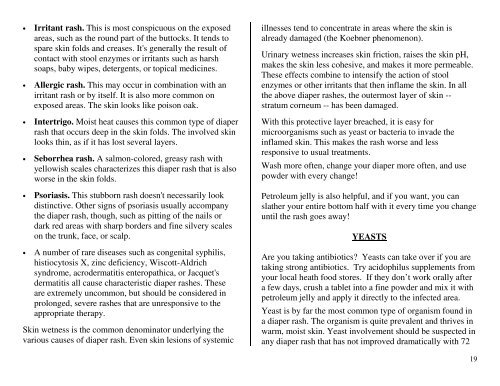The Twelve Month Diaper-Training Program - Deeker's Diaper Page
The Twelve Month Diaper-Training Program - Deeker's Diaper Page
The Twelve Month Diaper-Training Program - Deeker's Diaper Page
You also want an ePaper? Increase the reach of your titles
YUMPU automatically turns print PDFs into web optimized ePapers that Google loves.
• Irritant rash. This is most conspicuous on the exposed<br />
areas, such as the round part of the buttocks. It tends to<br />
spare skin folds and creases. It's generally the result of<br />
contact with stool enzymes or irritants such as harsh<br />
soaps, baby wipes, detergents, or topical medicines.<br />
• Allergic rash. This may occur in combination with an<br />
irritant rash or by itself. It is also more common on<br />
exposed areas. <strong>The</strong> skin looks like poison oak.<br />
• Intertrigo. Moist heat causes this common type of diaper<br />
rash that occurs deep in the skin folds. <strong>The</strong> involved skin<br />
looks thin, as if it has lost several layers.<br />
• Seborrhea rash. A salmon-colored, greasy rash with<br />
yellowish scales characterizes this diaper rash that is also<br />
worse in the skin folds.<br />
• Psoriasis. This stubborn rash doesn't necessarily look<br />
distinctive. Other signs of psoriasis usually accompany<br />
the diaper rash, though, such as pitting of the nails or<br />
dark red areas with sharp borders and fine silvery scales<br />
on the trunk, face, or scalp.<br />
• A number of rare diseases such as congenital syphilis,<br />
histiocytosis X, zinc deficiency, Wiscott-Aldrich<br />
syndrome, acrodermatitis enteropathica, or Jacquet's<br />
dermatitis all cause characteristic diaper rashes. <strong>The</strong>se<br />
are extremely uncommon, but should be considered in<br />
prolonged, severe rashes that are unresponsive to the<br />
appropriate therapy.<br />
Skin wetness is the common denominator underlying the<br />
various causes of diaper rash. Even skin lesions of systemic<br />
illnesses tend to concentrate in areas where the skin is<br />
already damaged (the Koebner phenomenon).<br />
Urinary wetness increases skin friction, raises the skin pH,<br />
makes the skin less cohesive, and makes it more permeable.<br />
<strong>The</strong>se effects combine to intensify the action of stool<br />
enzymes or other irritants that then inflame the skin. In all<br />
the above diaper rashes, the outermost layer of skin -stratum<br />
corneum -- has been damaged.<br />
With this protective layer breached, it is easy for<br />
microorganisms such as yeast or bacteria to invade the<br />
inflamed skin. This makes the rash worse and less<br />
responsive to usual treatments.<br />
Wash more often, change your diaper more often, and use<br />
powder with every change!<br />
Petroleum jelly is also helpful, and if you want, you can<br />
slather your entire bottom half with it every time you change<br />
until the rash goes away!<br />
YEASTS<br />
Are you taking antibiotics? Yeasts can take over if you are<br />
taking strong antibiotics. Try acidophilus supplements from<br />
your local heath food stores. If they don’t work orally after<br />
a few days, crush a tablet into a fine powder and mix it with<br />
petroleum jelly and apply it directly to the infected area.<br />
Yeast is by far the most common type of organism found in<br />
a diaper rash. <strong>The</strong> organism is quite prevalent and thrives in<br />
warm, moist skin. Yeast involvement should be suspected in<br />
any diaper rash that has not improved dramatically with 72<br />
19


